Introduction
In the world of men’s fashion, accessories play a vital role in completing a polished and put-together look. One such accessory that stands out is the timeless leather belt. A men’s leather belt not only serves the practical purpose of holding up your pants but also adds a touch of sophistication and style to your overall outfit. However, knowing how to wear a men’s leather belt correctly can make a significant difference in your appearance. In this comprehensive guide, we will explore various tips, techniques, and style recommendations on how to wear a men’s leather belt with confidence and flair.

Why Choose a Leather Belt?
Leather belts have been a staple in men’s fashion for centuries, and for good reason. The durability, versatility, and classic appeal of leather make it an excellent choice for a belt material.
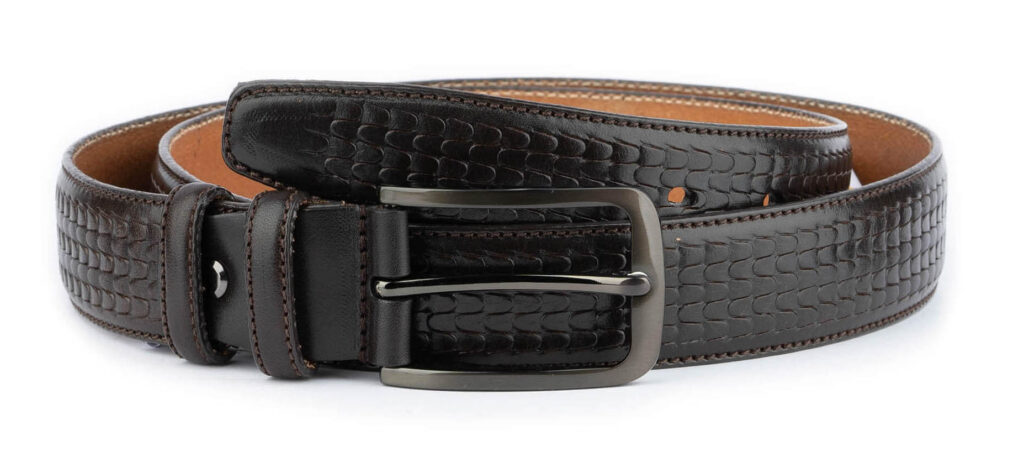
Leather belts not only withstand regular wear and tear but also develop a unique patina over time, giving them character and charm. Additionally, leather belts come in a wide range of colors, finishes, and styles, allowing you to express your personal style effortlessly.
Selecting the Right Leather Belt
When it comes to selecting a leather belt, there are a few factors to consider. First and foremost, choose a high-quality leather belt that is made from genuine leather rather than synthetic materials. Genuine leather belts offer superior durability and a luxurious feel. Look for belts with full-grain or top-grain leather, as they are the highest quality options available. Additionally, consider the belt’s width, buckle style, and color to ensure it complements your outfits seamlessly.
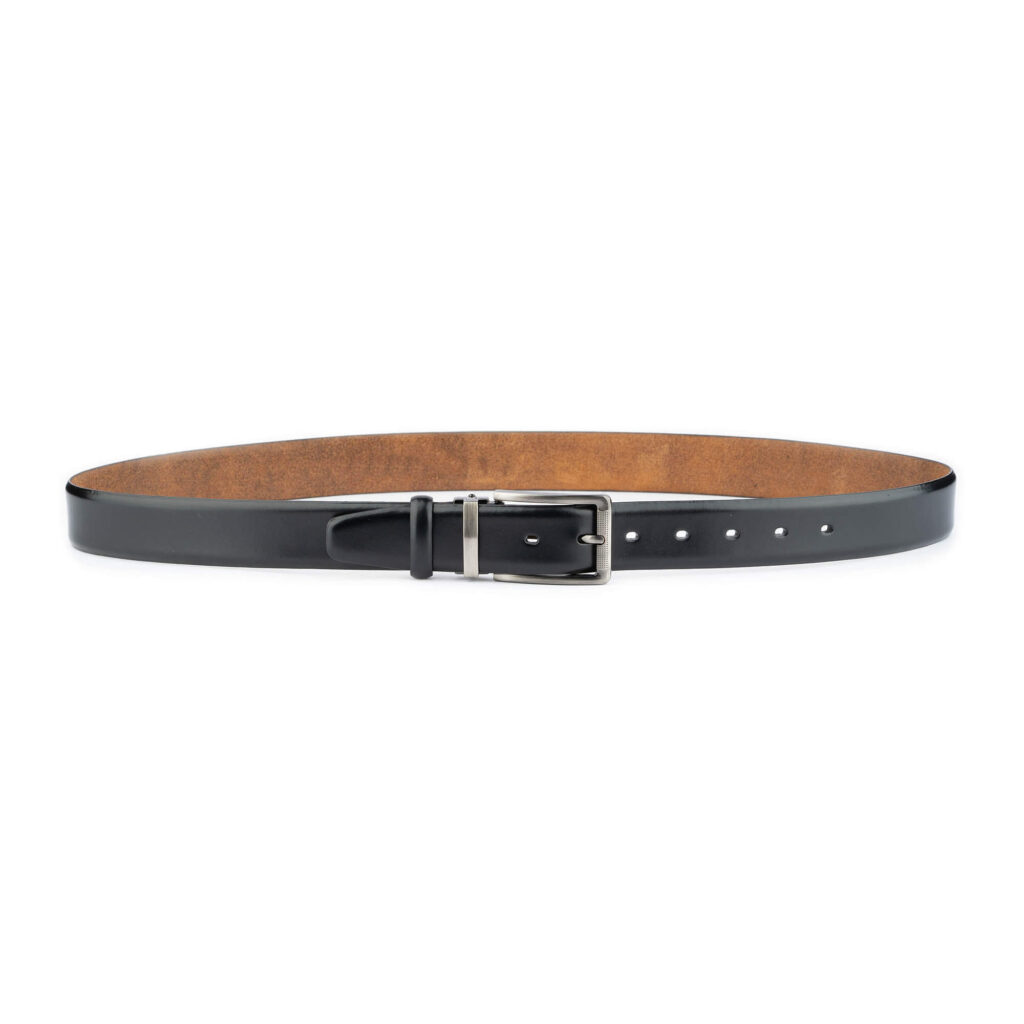
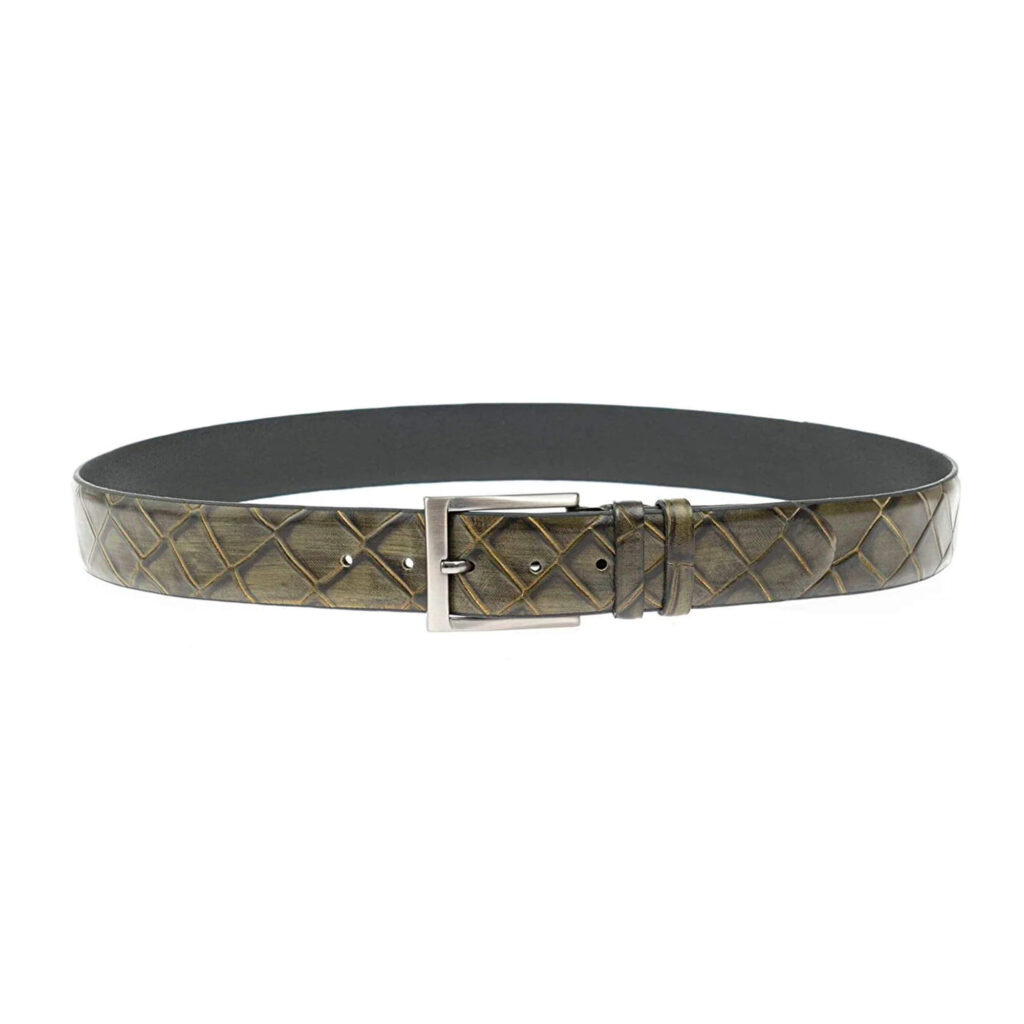

Determining the Correct Belt Size
Getting the right belt size is crucial for a comfortable and stylish fit. To determine your belt size, use a measuring tape and wrap it around your waist, where you usually wear your pants. Take note of the measurement and refer to a size chart to find the corresponding belt size. Keep in mind that belt sizes may vary slightly between brands, so it’s always a good idea to try the belt on before making a purchase. Remember, a properly fitted belt should have enough length to secure in the center hole.

Matching Your Belt with Your Outfit
To achieve a cohesive and polished look, it’s essential to match your belt with your outfit. Ideally, the color of your belt should coordinate with the color of your shoes. For formal occasions, a black leather belt paired with black shoes is a classic and foolproof choice. Similarly, brown leather belts work well with brown shoes, creating a harmonious ensemble. If you’re unsure about the color matching, opt for a versatile and timeless option like a brown leather belt, which pairs well with a wide range of shoe colors.
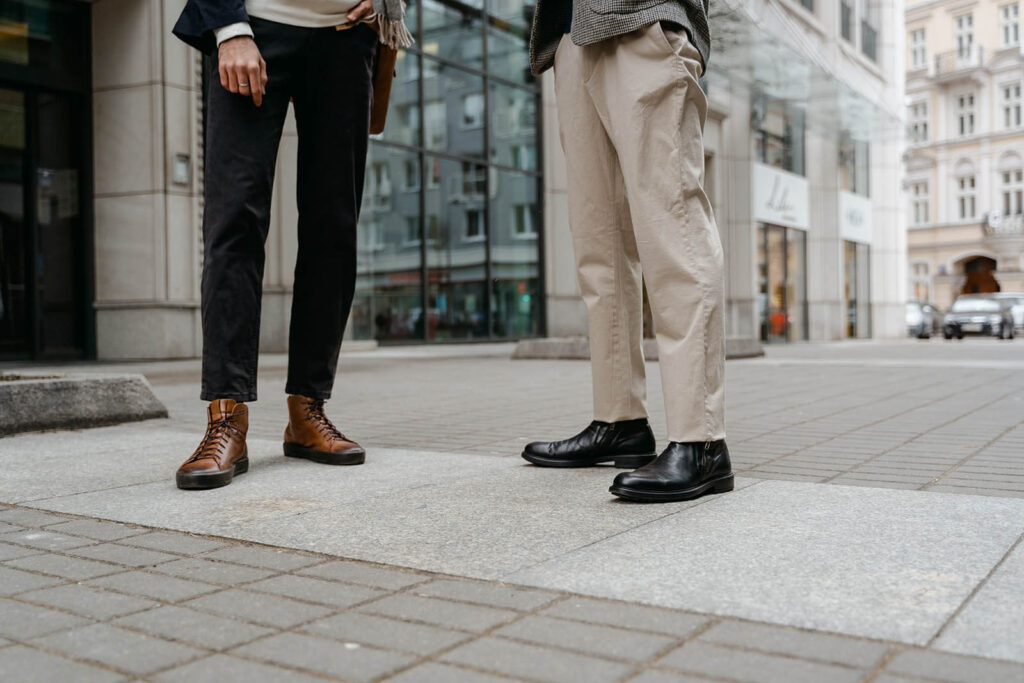



Casual vs. Formal Belt Styles
Understanding the distinctions between casual and formal belt styles is essential for appropriate outfit pairings. Casual belts typically have a wider width, ranging from 1.5 to 2 inches, and often feature a more relaxed buckle design. These belts are ideal for pairing with jeans, chinos, and other casual pants. On the other hand, formal belts are usually narrower, measuring around 1 to 1.25 inches in width, and come with sleek and understated buckles. Formal belts are best suited for dress pants, suits, and formal occasions.
Wearing a Leather Belt with Jeans
A leather belt can instantly elevate your casual jeans outfit. To achieve a stylish and balanced look, follow these steps:

- Choose the Right Width: Opt for a casual leather belt with a width of 1.5 to 2 inches. This width is ideal for jeans and complements the rugged aesthetic.
- Color Coordination: Match the color of your belt with the shade of your shoes. For a classic look, pair brown leather belts with brown shoes and black leather belts with black shoes.
- Tuck in Your Shirt: To showcase your belt, tuck in your shirt. This allows the belt buckle to become a focal point of your outfit.
- Avoid Overmatching: While coordinating colors is important, avoid overmatching every element of your outfit. A subtle contrast between your belt and shoes adds visual interest.
Remember, the key to wearing a leather belt with jeans is to strike the perfect balance between casual and put-together.
Pairing a Leather Belt with Dress Pants
When dressing up in formal attire, wearing the right belt is crucial. Follow these guidelines to pair a leather belt with dress pants:
- Choose a Formal Belt: Opt for a narrower leather belt with a width of around 1 to 1.25 inches. The buckle should be sleek and understated, preferably in a silver or gold tone.
- Coordinate Colors: Match the color of your belt with the color of your dress shoes. A black leather belt goes well with black shoes, while a brown leather belt complements brown shoes.
- Belt Loop Placement: Make sure to feed the belt through all the belt loops on your dress pants for a secure and polished look. Avoid skipping any loops, as this can disrupt the overall appearance.
- Tuck in Your Shirt: When wearing a dress belt, it’s best to tuck in your shirt. This allows the belt buckle to be on display and adds a touch of sophistication to your outfit.

By following these steps, you can confidently wear a leather belt with dress pants for formal occasions.
Coordinating Belt and Shoe Colors
Coordinating the color of your belt with your shoes is a fundamental aspect of wearing a leather belt. Here are some key points to consider:
- Black Belt: A black leather belt is a versatile choice that pairs well with black shoes. It’s an excellent option for formal occasions and works seamlessly with charcoal, navy, and black trousers.
- Brown Belt: Brown leather belts offer more versatility as they can be paired with a range of shoe colors. Light brown belts match well with tan or light brown shoes, while darker brown belts complement dark brown or burgundy shoes.
- Contrast or Match?: Choosing whether to match or create contrast between your belt and shoes depends on your personal style and the occasion. A matching belt and shoe combination offers a cohesive and refined look, while contrasting colors can add visual interest and a touch of individuality to your outfit.


Remember, coordinating belt and shoe colors demonstrates attention to detail and elevates your overall appearance.
Understanding Belt Buckles
Belt buckles come in various styles, each with its unique characteristics and suitability for different occasions. Here are some common belt buckle types:
- Prong Buckle: This is the most common type of belt buckle, featuring a prong that goes through one of the belt’s holes to secure it in place. Prong buckles are versatile and appropriate for both casual and formal outfits.
- Box Frame Buckle: Box frame buckles have a rectangular or square shape and often feature a hinged lid that opens to release the belt strap. These buckles offer a sleek and minimalist look, making them suitable for formal occasions.
- Automatic Buckle: Automatic buckles are designed with a sliding mechanism that allows for easy adjustment and quick release. These buckles are convenient and ideal for everyday wear.
- Military Buckle: Military buckles, also known as web buckles, are commonly found on canvas or nylon belts. They feature a sliding bar that locks the belt in place, offering durability and reliability.
- Western Buckle: Western-style belt buckles are typically large, ornate, and highly decorative. They are associated with cowboy culture and add a bold and distinctive touch to casual outfits.
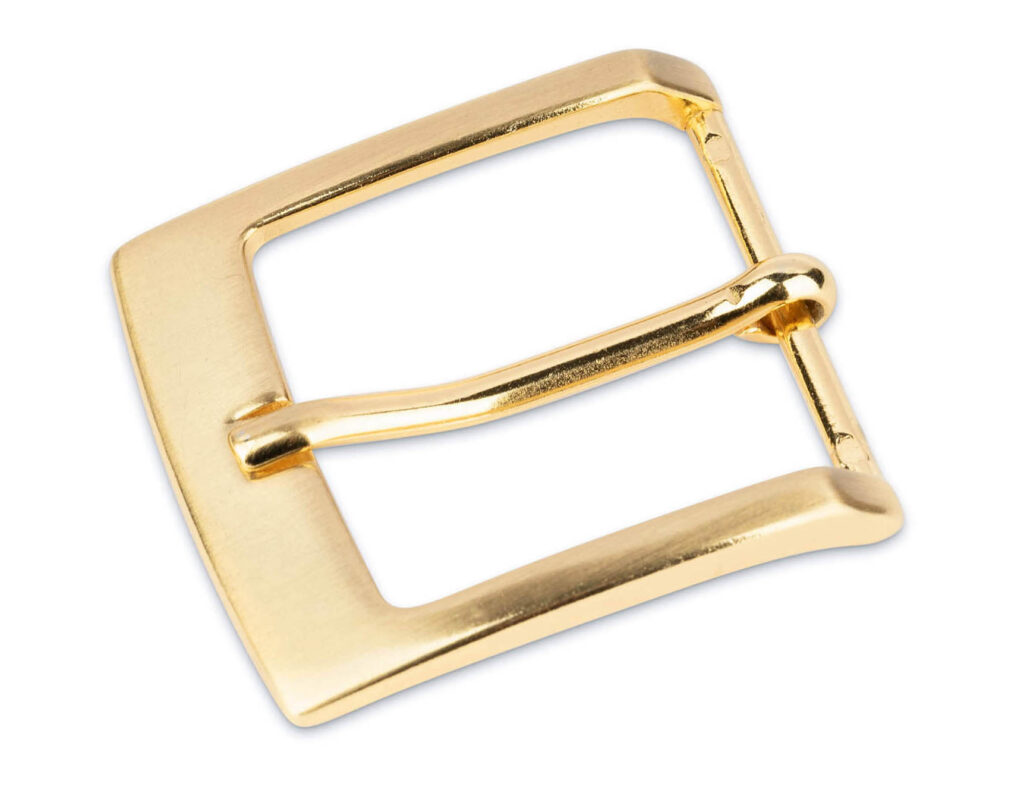




Understanding different belt buckle styles helps you choose the right buckle for the occasion and complements your personal style.
Belt Buckle Styles for Different Occasions
The choice of belt buckle style should align with the formality of the occasion and the overall aesthetic you want to achieve. Consider these recommendations:
- Formal Occasions: For formal events or professional settings, opt for a simple and understated belt buckle. A classic prong buckle or a box frame buckle in silver or gold tones will exude elegance and sophistication.
- Casual Gatherings: When dressing casually, you have more room to experiment with different belt buckle styles. Automatic buckles or vintage-inspired designs can add a touch of personality and complement your laid-back outfit.
- Western-Inspired Events: If you’re attending a western-themed event or want to embrace a cowboy-inspired look, a large and ornate western belt buckle is the perfect choice. These bold buckles make a statement and add a touch of rugged charm to your outfit.
- Outdoor Activities: For outdoor activities like hiking or camping, consider a military-style buckle or a web belt with a sturdy and reliable closure. These buckles are designed to withstand rugged conditions and offer practicality and durability.
Remember to choose a belt buckle style that aligns with the occasion, your outfit, and your personal style preferences.
Tucking in Your Shirt with a Belt
Tucking in your shirt can significantly impact the overall appearance when wearing a belt. Here are some tips to tuck your shirt correctly:
- Clean Lines: When tucking in your shirt, make sure the fabric lies smoothly without any wrinkles or bunching. This creates clean lines and gives a polished look to your outfit.
- Shirt Length: Pay attention to the length of your shirt. It should be long enough to stay tucked in throughout the day without coming undone.
- Belt Placement: After tucking in your shirt, position your belt on top of the fabric. This creates a seamless transition and ensures the belt buckle is visible.

Tucking in your shirt with a belt not only keeps your look neat but also allows the belt to become a prominent accessory in your ensemble.
Using a Belt as a Fashion Statement
While belts primarily serve a functional purpose, they can also be used as a fashion statement. Here are a few ways to make your belt a focal point of your outfit:
- Contrasting Colors: Choose a belt that contrasts with the color of your pants or shirt. For example, a vibrant red belt can add a pop of color to a neutral-toned outfit.
- Patterned Belts: Opt for belts with unique patterns or textures to make a bold statement. Animal prints, embossed designs, or woven patterns can add visual interest to your look.
- Statement Buckles: Select belts with eye-catching and ornate belt buckles. Intricate designs, personalized initials, or unique shapes can turn your belt into a conversation starter.
Using a belt as a fashion statement allows you to express your personal style and adds an element of creativity to your outfits.
Adding Personality with Belt Accessories
In addition to the belt itself, various accessories can further enhance its style and personality. Consider these options:
- Belt Straps: Swap out the belt strap to create different looks. Some belts allow you to detach and replace the strap, offering versatility and customization options.
- Belt Loops: Experiment with belt loops in different colors or materials. Leather, fabric, or metal loops can add a touch of uniqueness to your belt.
- Belt Chains: Attach a belt chain to your belt loops for a fashionable and edgy look. Belt chains come in various styles, such as chunky metal links or delicate pendant chains.



These accessories allow you to personalize your belt and create a style that reflects your individuality.
Maintaining and Caring for Your Leather Belt
To keep your leather belt in top condition and extend its lifespan, proper maintenance is essential. Follow these care tips:
- Regular Cleaning: Wipe your belt with a soft cloth regularly to remove any dirt or dust. For deeper cleaning, use a leather cleaner or mild soap diluted in water. Avoid submerging the belt in water, as it can damage the leather.
- Conditioning: Apply a leather conditioner periodically to keep the leather moisturized and prevent it from drying out or cracking. Follow the product instructions for the best results.
- Avoid Excessive Heat and Moisture: Keep your leather belt away from direct sunlight, heat sources, and excessive moisture. These can cause the leather to fade, warp, or develop mold.
- Proper Storage: When not in use, store your leather belt in a cool and dry place. Use a belt hanger or roll it up neatly to prevent creasing or deformation.
- Rotate Your Belts: If you own multiple leather belts, rotate their usage. This allows each belt to rest and maintain its shape, preventing excessive wear on a single belt.
By following these maintenance tips, you can ensure that your leather belt remains in excellent condition for years to come.
Can You Wear a Leather Belt with Suspenders?

The choice of wearing a leather belt with suspenders depends on personal style and comfort preferences. Here are some points to consider:

- Functionality: If you rely on a belt to hold up your pants securely, wearing suspenders alone may not provide the same level of support. In such cases, it’s best to wear a belt for practical reasons.
- Aesthetics: Combining a leather belt with suspenders can create a unique and stylish look. This combination adds visual interest and allows you to showcase both accessories simultaneously.
- Comfort: Some individuals find wearing both a belt and suspenders uncomfortable, as they can create unnecessary bulk around the waist. Experiment with different options to find what works best for you.
Ultimately, the choice to wear a leather belt with suspenders is a matter of personal preference and style.
How to Wear a Belt with Belt Loops
Wearing a belt with belt loops is the most common and straightforward method. Follow these steps for a proper fit:
- Thread the Belt: Insert the belt into the first belt loop on your pants, starting from the front. Ensure the buckle is facing outward.
- Weave through Belt Loops: Continue threading the belt through each belt loop, following the natural path from the front to the back. Avoid skipping any loops to maintain a secure fit.
- Buckle Placement: Once the belt is threaded through all the belt loops, fasten the buckle securely at the desired tightness. Adjust the position of the buckle so it is centered and sits comfortably.

Wearing a belt with belt loops ensures your pants stay in place and offers a polished and put-together look.
Experimenting with Belt Knots
For those looking to add a unique touch to their belt, experimenting with belt knots is an excellent option. Here are a few popular belt knots to try:
- The Basic Knot: This is the simplest and most common belt knot. After fastening the belt through the buckle, take the loose end and pass it over and then under the belt, creating a loop. Pull the loose end through the loop, tighten, and adjust as needed.
- The Two-Ring Knot: This knot adds a distinctive twist to your belt. After passing the loose end through the buckle, create a loop and bring the loose end back up through the loop. Then, pass it through the second loop formed by the belt, and tighten.
- The Tucked Knot: This knot is perfect for achieving a clean and minimalist look. After fastening the belt through the buckle, tuck the loose end underneath the belt on the inside. This creates a streamlined appearance without an exposed loose end.


Experimenting with different belt knots allows you to add a touch of creativity and individuality to your belt-wearing routine.
Dressing for Different Body Types

When it comes to wearing a belt, it’s important to consider your body type to ensure a flattering and comfortable fit. Here are some tips for different body types:
- Slim Body Type: For individuals with a slim physique, choose belts that are proportionate to your body size. Opt for narrower belt widths, as wider belts may overpower your frame.
- Athletic Body Type: If you have a muscular or athletic build, look for belts with a slightly wider width. This helps balance your proportions and adds definition to your waistline.
- Tall Body Type: For taller individuals, longer belt straps may be necessary to accommodate a larger waist circumference. Look for belts that provide ample length without compromising style.
- Plus-Size Body Type: If you have a plus-size body type, select belts that are wide enough to create a balanced look. Avoid overly narrow belts, as they can visually emphasize the width of your waist.


Remember, these are general guidelines, and personal style preferences should ultimately dictate your belt choices.
When Not to Wear a Belt
While belts are a versatile accessory, there are instances when wearing a belt may not be necessary or appropriate. Here are a few situations where you can opt to forgo a belt:
- Elastic Waistbands: Some pants, such as joggers or athletic wear, come with elastic waistbands that provide a secure fit without the need for a belt.
- Formal Waistcoats or Cummerbunds: When wearing a formal waistcoat or a cummerbund as part of a tuxedo or formal suit, a belt is not typically worn. These garments provide a polished and streamlined appearance without the need for additional accessories.
- Beltless Pants: Certain styles of pants, such as drawstring pants or those with hidden or decorative fastenings, are designed to be worn without a belt. Embrace the intended look of these pants and let them shine on their own.
In these situations, embracing the beltless look ensures a cohesive and appropriate outfit.
Common Mistakes to Avoid
When it comes to wearing a men’s leather belt, there are a few common mistakes that can detract from your overall look. Avoid the following pitfalls:
- Wearing an Ill-Fitting Belt: A belt that is too long or too short can disrupt the proportions of your outfit. Ensure the belt fits properly and has enough length to secure in the center hole comfortably.
- Mismatched Belt and Shoes: Failing to coordinate the color of your belt with your shoes can create a jarring and disjointed look. Take the time to match the colors for a polished appearance.
- Visible Belt Damage: Wearing a belt with visible wear and tear, scratches, or stains can diminish the overall aesthetic. Regularly maintain and care for your leather belt to keep it in pristine condition.
- Over-accessorizing: While belt accessories can be fun, avoid over-accessorizing with too many additional elements. Choose one or two accessories to maintain a balanced and stylish look.
By avoiding these common mistakes, you can ensure that your belt enhances your outfit rather than detracting from it.
Frequently Asked Questions
Should I wear a leather belt with a suit?
Yes, wearing a leather belt with a suit is recommended for a polished and put-together look. Choose a formal belt that matches the color of your shoes to maintain a cohesive appearance.
Can I wear a black belt with brown shoes?
Ideally, it’s best to match the color of your belt with your shoes. However, if done intentionally, a black belt with brown shoes can create a fashionable and contrasting look.
How do I clean a stained leather belt?
To clean a stained leather belt, start by wiping it with a damp cloth to remove surface dirt. For tougher stains, use a leather cleaner or a mild soap diluted in water. Gently scrub the stained area and rinse with a clean cloth. Allow the belt to air dry and apply a leather conditioner to restore moisture and shine.
What width should my leather belt be?
The width of your leather belt depends on the occasion and the pants you’re wearing. For casual outfits, belts with a width of 1.5 to 2 inches work well, while formal belts are generally narrower, around 1 to 1.25 inches.
Can I wear a leather belt with shorts?
Yes, you can wear a leather belt with shorts for a stylish and casual look. Opt for a narrower belt that complements the shorts’ style and color.
How tight should my belt be?
Your belt should be tight enough to hold up your pants without being uncomfortable or restrictive. Aim for a snug fit that allows you to move and breathe comfortably. Avoid tightening the belt excessively, as it may create an unflattering appearance and unnecessary pressure on your waist.
Conclusion
Mastering the art of wearing a men’s leather belt is key to creating a well-put-together and stylish look. By selecting the right belt, coordinating it with your outfit, and paying attention to details like belt size, buckle style, and shirt tucking, you can confidently wear a leather belt with flair. Experiment with different styles, knots, and accessories to add a personal touch, and remember to properly care for your leather belt to ensure its longevity.
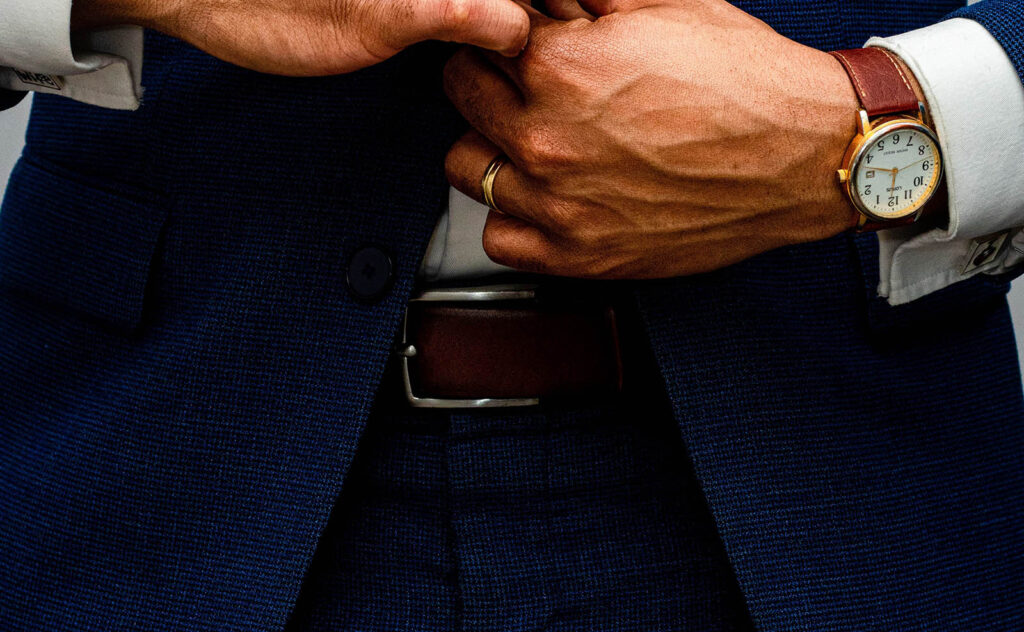
With these tips and guidelines in mind, you’ll be ready to rock any outfit with a men’s leather belt as your stylish accessory.Discover how to wear men’s leather belts with confidence and style. Learn about selecting the right belt, coordinating it with your outfit, and avoiding common mistakes. Find answers to FAQs and get expert tips on belt sizing, buckles, and more. Master the art of wearing men’s leather belts today.

I hope that the article you read provided you with useful information, sparked inspiration, or simply entertained you. Your time and attention are precious, and I am honored that you chose to spend them on my writing.
Best Regards,
Mike Giordano








